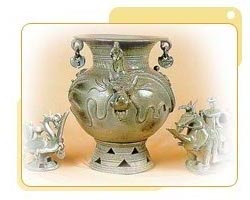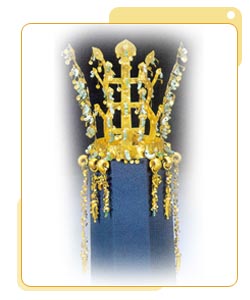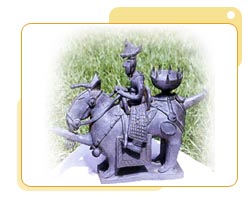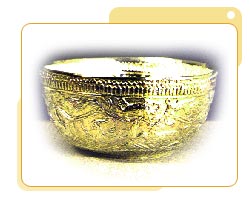|
|
| |
|
|
 |
 Ceramics
of the Shilla dynasty
Ceramics
of the Shilla dynasty |
 |
|

Shilla
earthenware was first produced around the first
century BC and was in use for the next thousand
years. It was made from clay that was widely distributed
in the Kyoungju area. Most Shilla earthenware
was fired at a high temperature of 1000º C, leaving
it with a grayish-blue tinge. Some, however, has
a different appearance because it was first coated
with the natural oil of pine needles, which burned
to ashes in the firing process.
The types of Shilla pottery vary with their uses.
Everyday types include Jangyungho, Gobae, Gakbae
and Youngbae. ('Bae' means cup.) Golho was used
for the dead, while the Shingu type, Cha type
and horseman flask type ceramics were of the finest
quality.
Thousands of these fine ceramics have been found
in the tombs of Shilla kings, such as Chenmachong,
Hwangnamdaechong, and Geumgwanchong. Accordingly,
many royal tombs in Kyoungju are looked upon as
treasuries of ceramics. The skills used in making
these Shilla pots show a high degree of originality
and creativity and had great influence on Japanese
Seuhyechi earthenware in the middle of the fifth
century AD. Today, reproductions of Shilla earthenware
are widely made.
|
 |
 Replica
of the golden crown
Replica
of the golden crown |
 |
|

The
original gold crown was unearthed in the Tomb
of the Flying Horse. This gold crown is 32.5 cm
high, and its decorations are 25.5 cm in length
and 20 cm in diameter. (National Treasure No 188)
The gold of this crown is thicker than the gold
of other crowns.
When it was discovered, the crown crown was on
the head of the firstborn son. It consists of
a broad band of gold which fits onto the head.
Graceful, outwardly-curving arms of gold stand
up vertically from this gold.
The arms have a triple row of trident decorations
at the front and a double row at the back. The
vertical arms at the back look like deer’s antlers.
The tridents are the characteristic shape of the
Chinese character, chool, which is Kyoungju’s
quintessential symbol.
This crown is of a kind which is a typical Shilla
design.
This replica gold crown very accurately reflects
the Shilla-dynasty style.
|
Workshop :
|
Samsunbang
746-7538
|
|
Materials used :
|
inside
- red copper / outside - gold-plate
|
|
Types available :
|
actual
size of the original, 2/3 of full size,
or 1/2 of full size
|
|
|
|
|
Transportation
: by car 20 minutes, by local bus (numbers
11, 101, 12, 102). Get off in
front of the Craft Village.
|
 |
 Ceramic
mounted warrior flask with horn spoots
Ceramic
mounted warrior flask with horn spoots |
 |
|

This is thought
to be a ritual vessel which was used in the memorial
ceremony for ancestors.
On the clay base stands a horse that has two short
spouts. One, which is quite short, is on the haunch
of the horse, and the other, longer spout is on
the horse’s breast. If we pour water into the
longer spout, it will come out of the longer spout
on the chest. The legs of the horse look rather
short and stocky, but the head has been molded
very realistically. The man riding on the horse
must be a nobleman of the Shilla dynasty, judging
by such luxurious things as his three-cornered
hat, pants made of deerskin and the finely-decorated
horse.
The other man standing beside the horse is wearing
a tall conical hat. He has a piece of towelling
tied around the topknot in his hair. In his hand,
he is carrying a (percussion) wood-block. From
all this, we might suppose that he is a trusted
servant who is leading the way for his master.
The meaning of this is that the horseman will
ascend into the sky for the dead, and it also
symbolizes the translation of the dead to heaven.
Although it has been commonly assumed that this
is a toy, it must be a ritual vessel along the
same pattern as other animal earthenware. In other
words, it is hollow inside, and the spouts, which
make it look like flask, are similar to those
on other animal earthenware. This animal earthenware
first came to light in the Gaya Area, but this
mounted-warrior flask can be placed in the Shilla
period.
Many replicas have been made of horseman flasks
of this kind, especially in the Folk Crafts Village.
|
|
|
|
Further
information: Folk Crafts Village (054) 746 - 7207
|

This
silver cup was discovered in the northern Huangnam
tomb, and it has been placed around the fifth or
sixth century of the Shilla dynasty.
A Chinese phoenix and human figures are depicted
on the side of the cup. The lines of the design
are slightly embossed. The bird and the figures
were first sketched on the inside of the bowl, and
hammered out from within.
The replica is a direct copy of this silver cup.
The photo is of the replica. The original is in
the Gyeongju National Museum.
|
Workshop :
|
Samsunbang
746-7538
|
|
Materials used :
|
99% pure
silver
|
|
Weight
:
|
100 -120g
|
|
 |
|
|
|
|
|